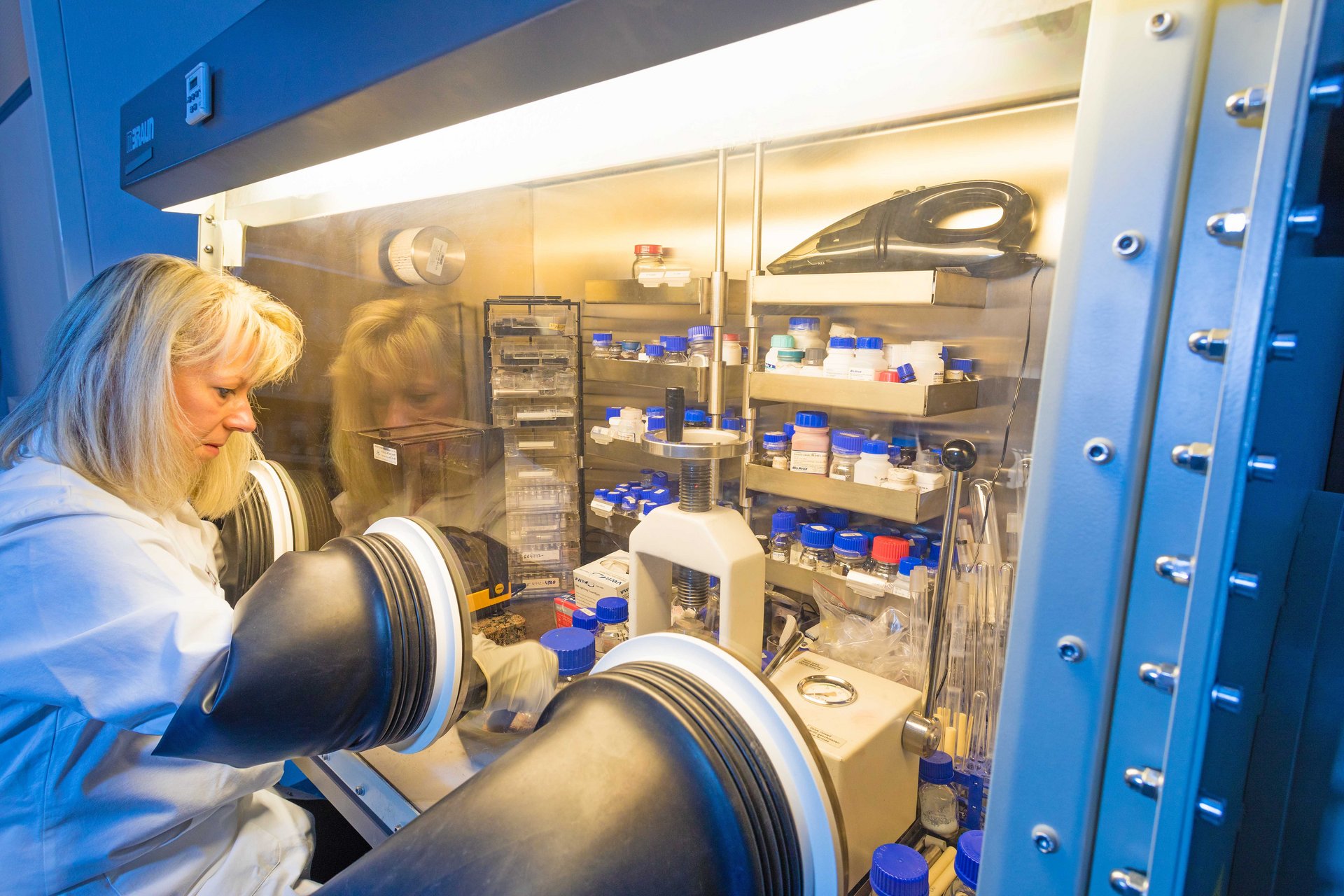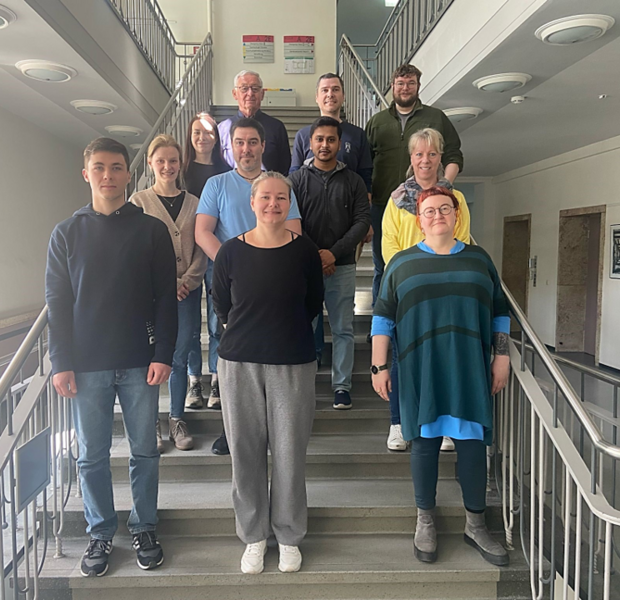

Head of Department: Dr. Sabine Wurmehl
Room D2E.13 Phone: +49 351 4659 519 Email

The pursuit of novel materials with emergent properties drives fundamental knowledge and technological advancements. Researchers from material science, solid-state chemistry, and physics collaborate to understand the intricate relationships between local composition, crystallographic structure, and microstructure in multifunctional materials.
A key aspect of our research is elucidating the mechanisms governing phase formation in response to external stimuli such as temperature, atmosphere, pressure, cooling rate, and material composition. By selectively modifying these experimental parameters we are able to tune specific functionalities in our samples.
The development or modification of growth methods may be necessary to synthesize materials with targeted properties in poly- or single-crystalline form. We explore the driving forces for a certain phenomenon and/or functionality by probing the structure-property relationships also in cooperation with partners.
Relevant materials may comprise but are not limited to (i) Heusler compounds as representatives for intermetallic materials with a myriad of different functionalities (ii) (Fe-based) unconventional superconductors (iii) magnetically frustrated systems where frustration may arise either from geometrical constraints or from competing interactions as found, e.g., in 3d-5d double perovskite and related structures.
Ultimately, our research aims to synthesize samples that converge to targeted properties. Their study gives us a deep understanding of specific phenomena and guides us towards the design of novel materials.

Project "Search for kagome Weyl type III semimetals" jointly with Bernd Büchner, Dima Efremov and Alexander Kordyuk funded by DFG
Topologically non-trivial semimetals are currently at the forefront of research in condensed matter physics, not only because of their unusual properties, but also because of their potential applications in a new generation of electronics for quantum computing and spintronics. The objective of our project is to explore Weyl III semimetal by striving to unveil and validate the first Weyl III semimetals by an international team from Dresden and Kiev. We focus on the exploration of less or not at all explored Co-based shandites as candidates for being kagome semimetals.
Workshop and project meeting with team of Ana de Oliveira Guilherme Buzanich (BAM), June 28th, 2024
“In-situ study of diffusion-controlled phase formation and grain growth in functional Heusler/perovskite materials using multimodal synchrotron-based techniques”
venue: IFW Dresden, Helmholtzstraße 20, 01069 Dresden, seminar room B3E.26
On the growth and characterization of SmOFe1−𝑥Co𝑥As single crystals
F. Anger, M.-I. Sturza, R. Firouzmandi, V. Kocsis, A. U.B. Wolter-Giraud, B. Büchner, S. Wurmehl
J. Cryst. Growth 627, 127473 (2024)
https://doi.org/10.1016/j.jcrysgro.2023.127473
We report the crystal growth of SmOFe1−𝑥Co𝑥As single crystals with Co content 0 ≤ 𝑥 ≤ 0.25 via the solid-state single crystal growth method at ambient pressure. We discuss in detail which are the optimal parameters for the growth of SmOFe1−𝑥Co𝑥As single crystals and rationalize the mechanisms to activate the diffusion-driven solid-state single crystal growth in the system under study. As expected across the series, charge doping suppresses the structural and magnetic transitions until for 5% Co content superconductivity is established. In particular, the splitting and clear differentiation of the structural and subsequent magnetic transition is rarely seen for 𝑅𝐸OFeAs compounds, but well resolved for the Fe-rich SmOFe1−𝑥Co𝑥As single crystals and even for the 𝑥 = 0.0125 crystal, but smeared out for the corresponding polycrystalline samples. Hence, the SmOFe1−𝑥Co𝑥As single crystal presented in this work are of exceptional high quality.
Phase transformation in Mn3Ga considering different degrees of deformation
Gloria Kirste, Jens Freudenberger, Sabine Wurmehl
Acta Materialia 258, 119205 (2023)
https://doi.org/10.1016/j.actamat.2023.119205
Anomalous Hall effect and magnetoresistance in microribbons of the magnetic Weyl semimetal candidate PrRhC2
Mickey Martini, Helena Reichlova, Laura T. Corredor, Dominik Kriegner, Yejin Lee, Luca Tomarchio, Kornelius Nielsch, Ali G. Moghaddam, Jeroen van den Brink, Bernd Büchner, Sabine Wurmehl, Vitaliy Romaka, and Andy Thomas
Phys. Rev. Materials 7, 104205 (2023)
https://doi.org/10.1103/PhysRevMaterials.7.104205
Flux Growth and Characterization of Bulk InVO4 Crystals
O. Voloshyna, M. V Gorbunov, D. Mikhailova, A. Maljuk, S. Seiro, B. Büchner
Crystals 13, 1439 (2023)
https://doi.org/10.3390/cryst13101439
The flux growth of InVO4 bulk single crystals has been explored for the first time. Crystals of InVO4 of typical size 0.5 × 1 × 7 mm3 were obtained using copper pyrovanadate (Cu2V2O7) as a flux, using Pt crucibles. X-ray absorption spectroscopy showed that oxidation states of indium and vanadium ions are +3 and +5, respectively. The size and high quality of the obtained InVO4 crystals makes them excellent candidates for further study of their physical properties.
Magnetic structure of the swedenborgite compound CaBaMn2Fe2O7 derived by powder neutron diffraction and Mössbauer spectroscopy
N. Qureshi, R. Morrow, M. Valldor, I. Puente-Orench, P. Adler
Phys. Rev. B 106, 144428 (2022)
https://doi.org/10.1103/PhysRevB.106.144428
A combination of neutron diffraction and 57Fe Mössbauer spectroscopy on a powder sample of swedenborgite CaBaMn2Fe2O7 shows that the undistorted hexagonal crystal structure (space group 𝑃63𝑚𝑐) is preserved down to low temperatures, and undergoes transition into a magnetically long-range ordered phase at 𝑇N = 205 K. The magnetic Bragg peak intensities from the powder diffraction patterns along with a symmetry analysis of the employed models unambiguously reveal the classical √3×√3 magnetic structure on a hexagonal lattice with propagation vector 𝐪=(13130). The nuclear Bragg peak intensities confirmed statistical distribution of Fe and Mn ions on both trigonal and kagome sites of the complex swedenborgite structure.
Current projects
DFG project "Search for kagome Weyl type III semimetals", PL Büchner, PL Wurmehl, PL Kordyuk
DFG project "In-situ study of diffusion-controlled phase formation and grain growth in functional Heusler/perovskite materials using multimodal synchrotron-based techniques“ PL A. Guilherme Buzanich (BAM, Berlin), PL Wurmehl
SFB 1143: Correlated Magnetism: From Frustration To Topology - Synthesis, crystal growth, and phase diagrams of frustrated magnets (B01) PL Dr. Anna Wolter-Giraud (IFW), PL Wurmehl
Integrated Research Training Group (MGK) as part of SFB 1143: PL Timm, PL Kaiser, PL Wurmehl
Completed projects
DFG project "Neue intermetallischen basierenden auf Seltenerdmetallen Verbindungen als Kandidaten für Realisierung des Shastry-Sutherland-Gitters" (PL Romaka)
DFG "Exploring the Nuclear Magnetic Resonance (NMR) technique as tool for modern materials research" (PL Wurmehl)
BMBF UKRATOP "Topological order of electrons in solids: New materials, Phenomena & Application Concepts"
BMBF -ERA-RUS-NET "New Layered Intermetallic Iron-based Superconductors and Related Compounds" (coordinated by PL Wurmehl)
DFG "Rationale Synthese neuartiger niedrigdimensionaler Materialien durch Abstimmung des Fermi-Niveaus durch chemische Dotierung" (PL Sturza)
DFG-materials world network "Halbmetallischer Transport in chemisch komplexen Systemen" (with P. Woodward and F.Y. Yang, both OSU, Ohio, USA; PL Wurmehl)
DFG "Tetragonal distorted Mn3-xGa Heusler compounds: Novel hardmagnetic materials without 4f electrons" (PL Wurmehl)
DFG "Synthesis and crystal growth of new and well-established iron pnictide superconductors" (PL Büchner, PL Wurmehl)
DFG "GRK 1621: Itinerant Magnetism and Superconductivity in Intermetallic Compounds" (Wurmehl as participating researcher)
DFG_Emmy- Noether-Project "Optimierte Heusler Verbindungen für die Spintronik durch Kontrolle der Struktur-Eigenschaftsbeziehungen" (PL Wurmehl)
DFG "NMR als Methode zur strukturellen Charakterisierung sowie zur Messung der Spinpolarisation halbmetallischer Ferromagnete" (PL Wurmehl, research stay at TU Eindhoven)

Scientists:
Dr. Luminita Harnagea (visiting scientist; IISER Pune, India)
Gloria Kirste
Robin Kramer
Dr. Wolfgang Löser
Dr. Andrej Maljuk
Dr. Ryan C. Morrow; see personal webpage
Domenic Nowak
Tamara Ruprecht (nee Holub)
Prof. Dr. Surjeet Singh (visiting scientist; IISER, Pune, India)
Dr. Sabine Wurmehl, see personal wepbpage
Technicians:
Christian Blum
Robert Kluge
Chika Schlage (training)
Rowena Wachtel
In memoriam Dr. G. Behr (former group leader)
Former group members
Dr. Alexey Alfonsov
Dr. Morgan Allison
Dr. Felix Anger
Dr. Gizem Aslan-Cansever
Dr. Saicharan Aswartham
Robert Beck
Dr. Maria Eleni Belesi
Mira D.R. Brandt
Margitta Deutschmann
Dr. Tusharkanti Dey
Patrizia Fritsch
Dr. Markus Gellesch
Yasin Hacisalohoglu
Dr. Franziska Hammerath
Franziska Harder (nee Seifert)
David Hettmann
Vakula Hlushko
Dr. Myroslava Horiacha
Dr. Rhea Kappenberger
Dr. Andrii Karnak
Dr. Seunghyun Khim
Kristina Leger
Christine Malbrich
Dr. Kaustuv Manna
Stefan Marx
Dietmar Meiler
Rosemarie Müller
Sabine Müller-Litvanyi
Ivan Mershiev
Dr. Claudia Nacke
Frank Naumann
Madleen Nicklisch
Dr. Ahmad Omar
Dr. Steven Rodan
Dr. Vitaliy Romaka
Dr. Miroslava Sakaliska
Dr. Silvia Seiro
Michael Schulze
Dr. Shiv Singh
Anastasia Smerechuk
Hannes Stummer
Sebastian Storch
Dr. Mihai I. Sturza
Ilka Vicon
Dr. Michael Vogl
Oleg Volkonskyi
Dr. Olesia Voloshyna
Jochen Werner
Robert Zaunick
Andreas Zimmermann